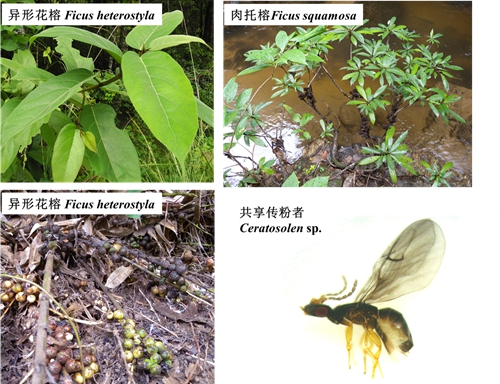The relationship between fig trees (Ficus spp.) and their fig wasp pollinators (Agaonidae) is usually typified as being strictly obligate, with each Ficus species pollinated by one host plant-specific agaonid species that enters the figs in order to lay its eggs. However, increasing numbers of species are known to be pollinated by more than one fig wasp. Sharing of pollinators is more likely to develop when two Ficus species have figs that share similar physical characteristics and the volatile profiles that allow pollinator entry and oviposition. Prof. PENG Yanqiong and her team of Xishuangbanna Tropical Botanical Garden (XTBG) tested the hypothesis that host switching was being facilitated by similarities between the two species. They asked whether the two plants grow together and whether their size and location on the trees similar. They also observed whether the seasonal development of their figs and leaves similar. They examined factors facilitating observed host switching at Xishuangbanna in Southwestern (SW) China, where Ficus squamosa is at the northern edge of its range and lacks the fig wasps that pollinate it elsewhere, and its figs are colonized by a Ceratosolen pollinator that routinely breeds in figs of F. heterostyla. They recorded the habitat preferences of F. squamosa (a shrub found near fast-flowing rivers) and F. heterostyla (a small tree of disturbed forest edges) at Xishuangbanna, and compared characteristics such as fig size, location and colour at receptive phase. Furthermore, the vegetative and reproductive phenologies in the populations of F. squamosa and F. heterostyla were recorded weekly at Xishuangbanna Tropical Botanical Garden (XTBG) for 1 year. Although preferring different habitats, the two fig species can be found growing close together. They have figs located at or near ground level, but differ in size when pollinated. Fig production in F. squamosa was concentrated in the cold and dry months of the year. F. heterostyla produced more figs in summer but had some throughout the year. The results show why it is possible for the routine pollinator of F. heterostyla to enter figs of F. squamosa. The figs probably also share similar attractant volatiles. This host switching suggests one mechanism whereby fig trees can acquire new pollinators and emphasizes the likely significance of edges of ranges in the genesis of novel fig tree–fig wasp relationships. The study entitled “Complementary fruiting phenologies facilitate sharing of one pollinator fig wasp by two fig trees” has been published in Journal of Plant Ecology. 
|

